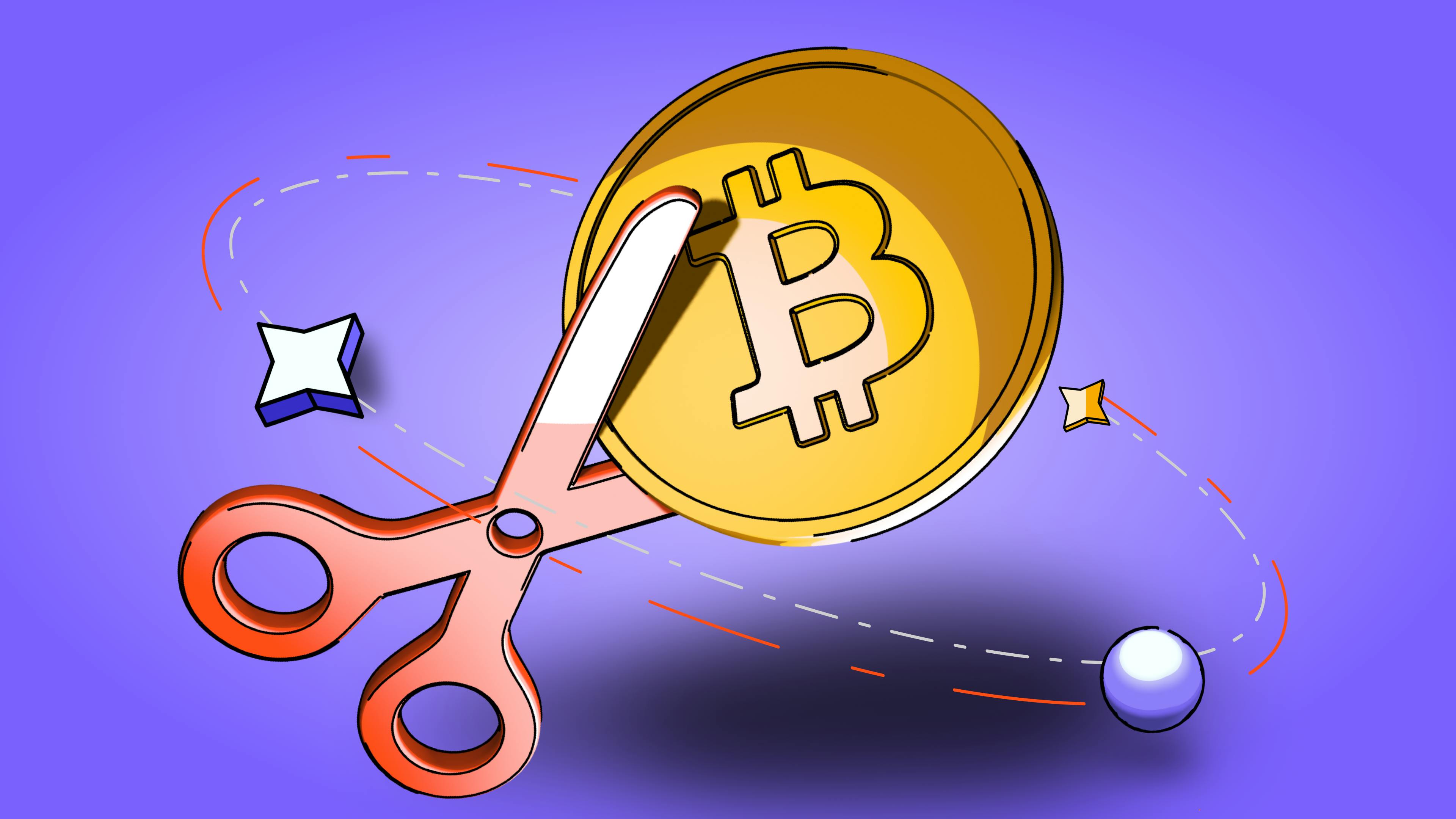Bitcoin Halving 2024: All You Need to Know
December 5, 2025

by Coinmetro Editorial Team
December 5, 2025
Bitcoin Halving is a significant event in the cryptocurrency world, designed to reduce the number of new coins created and earned by Bitcoin miners by half. This event happens approximately every four years, and it has had, so far, substantial effects on the cryptocurrency's supply, demand, and price. The next Bitcoin Halving will occur sometime in the middle of April, 2024, when the reward for mining a new block will be reduced from 6.25 to 3.125 BTC. Read on to find out why this is important and how it may affect Bitcoin and the markets at large.
Bitcoin Halving occurs every 210,000 blocks to halve the reward for mining Bitcoin transactions. This mechanism was integrated into Bitcoin by its creator, Satoshi Nakamoto, to control Bitcoin's inflation rate and supply. By reducing the reward for mining activities, Bitcoin creates scarcity and deflationary properties, enhancing its value over time.
First Halving (2012): Occurred on November 28, 2012, reducing the mining reward from 50 BTC to 25 BTC. The price of Bitcoin was approximately $12.35 on the halving day.
Second Halving (2016): Happened on July 9, 2016, with rewards falling from 25 BTC to 12.5 BTC. Bitcoin's price on this day was around $650.53.
Third Halving (2020): On May 11, 2020, the reward decreased from 12.5 BTC to 6.25 BTC, and the price was roughly $8,821.42.
Each halving has historically led to fluctuations in Bitcoin's price, often resulting in a significant increase in value over the following years. However, it's crucial to remember that while past trends can offer insights, they do not guarantee future outcomes due to the highly volatile and speculative nature of the cryptocurrency market.
The Bitcoin Halving aims to reduce the rate at which new Bitcoins are generated, thereby limiting the supply. This scarcity is a key reason why Bitcoin is often compared to gold and is considered a store of value. The process is set to continue until around the year 2140, when the maximum supply of 21 million Bitcoins is expected to be reached. While new gold is being dug out of the ground everyday, it becomes increasingly hard to extract it from the earth’s crust. However, while there are still significant amounts of gold on Earth, there will only be 21 million BTC. This feat puts Bitcoin in a league of its own and more and more investors are beginning to understand the deflationary and scarcity characteristics that Satoshi hard-wired into Bitcoin.
The 2024 Bitcoin halving is marked by distinct factors setting it apart from previous events. Notably, this is the first time Bitcoin has reached a new all-time high (ATH) before a halving, potentially driven by the introduction and adoption of Bitcoin ETFs and a vibrant ecosystem development.
ETFs have played a significant role in Bitcoin's market dynamics this cycle. They have absorbed significant sell pressure that typically comes from newly mined bitcoins. As the block reward drops from 6.25 BTC to 3.125 BTC, the associated sell pressure is expected to halve, potentially easing the downward pressure on Bitcoin's price. The inflow into Bitcoin ETFs has been substantial, mirroring the market's growing maturity and investor interest. These dynamics suggest a potential for increased Bitcoin prices post-halving, as reduced sell pressure meets sustained or increased demand.
The halving reduces the block reward, directly impacting miners' revenues. This can lead to a reevaluation of mining operations, particularly for those with higher operational costs. However, the increased transaction fees, partly due to new applications like ordinals, could help offset some of the lost block rewards. Network security, in turn, hinges on the profitability and sustainability of mining operations. While concerns exist regarding potential centralization and security risks if smaller miners exit, at the same time, other entities may be tempted to enter the mining industry and reap the rewards themselves as Bitcoin becomes more scarce, strengthening the Bitcoin blockchain furthermore with their participation.
With the pre-halving all-time high for Bitcoin that occurred on March 5, 2024, we can now say indeed that “this time is different”. However, what this means precisely is up for debate, speculation and educated guess:
Increased Market Volatility: The recent ATH before the halving can potentially lead to further increased market volatility. As prices reach new highs, both retail and institutional investors may attempt to time the market, leading to rapid price movements and potentially higher trading volumes.
Miner Behavior Changes: High Bitcoin prices can lead to increased profitability for miners, encouraging more mining activity. However, as the halving approaches and rewards are halved, less efficient miners may be forced out if they cannot sustain profitability, potentially impacting network hash rate temporarily.
Speculative Trading Surge: A new ATH often attracts speculative leverage traders looking for short-term gains. This can amplify price fluctuations and lead to a more speculative market environment, which might spook out novice traders and investors unfamiliar with crypto volatility.
Shift in Investor Sentiment: While a new ATH can boost overall sentiment and attract new investors, there's also the risk of a sudden shift if the market corrects post-halving. Investors expecting continued rapid growth due to the halving might be disappointed, leading to potential sell-offs.
Impact on Adoption: The visibility of reaching a new ATH pre-halving is already increasing public and media attention, potentially accelerating adoption and integration of Bitcoin into mainstream finance. However, if followed by a significant drop, it could also lead to skepticism from the same media outlets.
While historical trends and market sentiment can inform predictions, they do not guarantee future outcomes. The cryptocurrency market remains highly unpredictable, and numerous external factors can impact Bitcoin's price and the broader market dynamics.
Supply-Demand Economics Behind Halving: Bitcoin's halving events reduce the rate at which new BTC enters the market, affecting supply and demand dynamics. When the supply of new bitcoins decreases (assuming demand remains the same or increases), the price should theoretically rise due to the scarcity effect. Bitcoin's value is also underpinned by its capped supply at 21 million coins, enhancing its scarcity and potential value as demand grows.
Historical Trends Post-Halving: Previous halving events have shown a trend of price increases. For example, after the 2012 and 2016 halvings, Bitcoin experienced significant price surges. The halving in 2020 also saw a price increase, with Bitcoin eventually reaching an all-time high. These patterns indicate that halvings can create positive market sentiment, driving up demand and price due to anticipated reduced supply.
Speculative Outlook for 2024 and Beyond: The upcoming 2024 halving is expected to follow the historical pattern, with many in the crypto space anticipating potential price increases. Institutional interest and the regulatory environment will play crucial roles in shaping Bitcoin's acceptance and market dynamics around the halving. Price predictions vary, with some optimistic forecasts suggesting significant increases.
Impact on Miners and Network Security: As previously mentioned, halving events reduce the mining rewards, directly impacting miners' profitability. This can lead to a temporary drop in mining activity, as less efficient miners may be forced to exit the market. However, on the other hand, the mechanism ensures that despite the reduced block rewards, the network remains secure as it becomes more scarce and potentially more valuable, also incentivizing other miners to join in the process.
Investor Considerations: For investors, understanding the implications of the halving is crucial for making informed decisions. While historical trends suggest potential price increases post-halving, the cryptocurrency market's inherent volatility necessitates a cautious approach. Investors should perform thorough research and consider market sentiment, technological developments, and broader economic factors when assessing Bitcoin's post-halving outlook.
Scalability Challenges and Layer 2 Solutions: Bitcoin's original design, while revolutionary, faced scalability issues due to its limited transaction rate and block creation time. To address these, Layer 2 solutions such as the Lightning Network and Stacks have been developed. These solutions work off the main Bitcoin blockchain to improve transaction speeds and reduce costs. They include various mechanisms like state channels, rollup chains, and sidechains to facilitate this improved functionality without compromising on security or decentralization inherent to Bitcoin.
Stacks and Community Engagement: Stacks (STX) has emerged as a notable Layer 2 solution, bringing smart contract capabilities and decentralized applications (dApps) to Bitcoin, expanding its use cases beyond simple transactions. While leveraging Bitcoin's security, there's increasing excitement and discussion around Bitcoin's scalability and Stacks' role, highlighted by various industry reports and expert commentary. These developments reflect a broader recognition and utilization of Bitcoin's underlying potential.
Innovations in Bitcoin Ecosystem – Taproot and Wallets: The introduction of the Taproot upgrade has been a critical development, enhancing Bitcoin’s privacy, efficiency, and smart contract capabilities. Taproot-enabled wallets exemplify this progress, offering users enhanced features while maintaining the integrity and security of the Bitcoin network. Such wallets and the continued innovation within the Layer 2 space demonstrate Bitcoin's adaptability and the community's commitment to addressing technological challenges.
The developments in Bitcoin's Layer 2 solutions not only address existing scalability challenges but also open new avenues for growth and application. These advancements ensure that Bitcoin remains at the forefront of the cryptocurrency space, adapting to user needs and technological demands while maintaining its foundational principles.
The 2024 Bitcoin Halving is anticipated to be a pivotal event, continuing the cryptocurrency's tradition of reducing mining rewards, this time from 6.25 to 3.125 BTC. This programmed scarcity is expected to impact Bitcoin's supply and potentially increase its value, as has been seen in past halvings. The exact impact remains speculative but historically, halvings have been followed by price increases and heightened market interest.
For miners, the halving represents a mix of challenge and opportunity. While reduced rewards could mean lower immediate income, the potential rise in Bitcoin's price could compensate for the diminished BTC quantity. This scenario encourages miners to innovate and improve their operations' efficiency. On the other hand, the prospect of future gains might attract new participants to mining or motivate existing miners to enhance their setups, thereby strengthening the network's overall security and resilience.
Investors and Bitcoin enthusiasts should monitor the market closely as the halving approaches. Past trends suggest potential price increases, but the exact outcome depends on various factors, including global economic conditions and institutional adoption. The 2024 halving comes after a new ATH, amid growing interest from both retail and institutional sectors, which could amplify its effects compared to previous events. In other words, “this time is different” is actually true. How different, remains to be seen.
Remember, while the halving is a significant event with a historically bullish sentiment, the cryptocurrency market is inherently volatile. Making informed decisions based on comprehensive research and considering multiple viewpoints will be key to navigating the upcoming halving event successfully.
Join the Coinmetro community on Discord and Telegram, where forward-thinking traders and investors gather to share insights, explore new opportunities, and dive deep into the world of cryptocurrencies. Should you need any help, feel free to reach out to our world-class Customer Support Team via 24/7 live chat or email at hello@coinmetro.com.
To become a Coinmetro user today, Sign Up now, or head to our new Exchange if you are already registered and experience our premium trading platform.
Tags
Related Articles

Regulatory Sandboxes: Fostering Crypto Innovation Within Legal Frameworks
The cryptocurrency industry’s fast rise fuels an important debate. Innovation aims to transform finance, enhancing speed and access. Yet, regulators…
5m

Crypto Options Trading: Strategies and Market Insights
Cryptocurrency markets have rapidly expanded beyond simple buying and selling. One of the most significant developments has been the rise of…
6m

The Rise of Social-Fi: Blending Social Media with Decentralized Finance
In recent years, social media and finance have started to merge, creating Social-Fi. This concept blends the engagement of social platforms with…
6m

DeFi Insurance Platforms to Watch in 2024
Decentralized Finance (DeFi) insurance addresses the growing need for insurance against hacks, smart contract failures, and other DeFi-related risks.…
7m